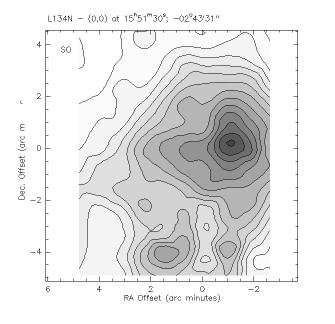
(Figure 6)
The emission can, in general, be characterized as the number of
photons received by the telescope, with stronger emission therefore
tracing more photons. The differences seen in the spatial
distribution of molecular emission within the Orion cloud are quite
striking, with the CH OH
emission strongest near the center of the map at the position of an
embedded cluster of young stars, while the N
OH
emission strongest near the center of the map at the position of an
embedded cluster of young stars, while the N H
H emission has a minimum at the
position of the embedded stars, reaching a peak further to the north.
These differences have been demonstrated by SWAS team members Ted
Bergin, Paul Goldsmith, and Ronald Snell to be the result of
variations in the chemical abundances of these species.
The OMC-1 core is one of many GMC cores,in our galaxy and with such a high
degree of chemical complexity sources like OMC-1 will be prime targets
for the SWAS satellite.
emission has a minimum at the
position of the embedded stars, reaching a peak further to the north.
These differences have been demonstrated by SWAS team members Ted
Bergin, Paul Goldsmith, and Ronald Snell to be the result of
variations in the chemical abundances of these species.
The OMC-1 core is one of many GMC cores,in our galaxy and with such a high
degree of chemical complexity sources like OMC-1 will be prime targets
for the SWAS satellite.
In addition, models of the chemistry in OMC-1 region and in other
cores have predicted that the atomic oxygen abundance is depleted onto
grains from the cosmic value. Since the abundance of water and
molecular oxygen are also dependent on the abundance of atomic oxygen
SWAS observations will provide the only direct method of verifying
these claims. The large scale mapping observations of neutral carbon
and 
 CO planned by SWAS will also be
valuable in testing current theoretical models of chemistry and
structure of dense star forming molecular cores.
CO planned by SWAS will also be
valuable in testing current theoretical models of chemistry and
structure of dense star forming molecular cores.
II. DARK CLOUD CORES
Dark cloud cores are also sites of high density situated within a
larger extended cloud. However, these cores are, in general, smaller
(diameter 0.3 ~ pc), colder (T ~ 10 K), and less dense (n ~ 10 cm
cm ) than
their giant cloud counterparts. In addition to being smaller, dark
cloud cores do not form as many massive stars as giant cloud cores and
therefore are thought to contain more pristine molecular material,
material which has not been affected by the formation of stars. As
such, these cores offer excellent targets for SWAS because an
understanding of the conditions of molecular clouds prior to the
formation of stars is required in order to understand the formation
process itself.
) than
their giant cloud counterparts. In addition to being smaller, dark
cloud cores do not form as many massive stars as giant cloud cores and
therefore are thought to contain more pristine molecular material,
material which has not been affected by the formation of stars. As
such, these cores offer excellent targets for SWAS because an
understanding of the conditions of molecular clouds prior to the
formation of stars is required in order to understand the formation
process itself.
Figure 7 presents a picture of one quiescent dark cloud core,
L134N (Lynds 134N) in a transition of the oxygen bearing molecule
sulfur monoxide (SO).

(Figure 7)
L134N will be a key SWAS target because this source is known to
contain high amounts of oxygen bearing molecules. In fact, this is
the only source in this galaxy, or any galaxy, where molecular oxygen
has been observed. In 1993 astronomers using the POM-2 telescope in
Meudon, France announced the tentative detection of isotopic oxygen

 O
O O in L134N
after many days of integration. Isotopic oxygen can be observed from
the Earth only under certain conditions. Using SWAS, astronomers
should be able to verify this detection within a few orbits because
SWAS will be observing the most abundant form of molecular oxygen,
O in L134N
after many days of integration. Isotopic oxygen can be observed from
the Earth only under certain conditions. Using SWAS, astronomers
should be able to verify this detection within a few orbits because
SWAS will be observing the most abundant form of molecular oxygen,

 O
O , which
is believed to be 500 times more abundant than
, which
is believed to be 500 times more abundant than 
 O
O O.
O.
[Back]